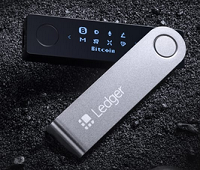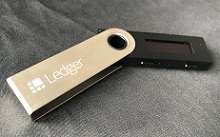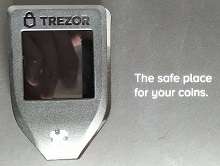If you are looking for a Tezos (XTZ) Wallet, then you have come to the right place. In this article we introduce you to the best XTZ wallets, sorted by their level of security. Accordingly, we first introduce you to the best Tezos hardware wallets, followed by the best Tezos desktop, mobile and web wallets.
Before we come to our ranking, it is important that you have a basic understanding of the technology and the different types of crypto wallets. Therefore, we have prepared a small theoretical introduction to the topic. If you want, you can also skip this part (click here!).
A crypto wallet is a virtual wallet which, in contrast to wallets for paper money, does not store the money itself, but the access keys for it. The access keys are the so-called “private keys”. Depending on whether they are stored online or offline, there are two different types of wallets:
- Cold wallets and
- Hot wallets
The distinction between these two types is made on the basis of the characteristic “connection to the Internet”. Cold wallets keep the private keys offline. This means that the access keys are never connected to the Internet. This means that hackers have no way of accessing the access keys. In contrast, hot wallets store the private keys online. This means that the storage medium for the private key is at least temporarily in contact with the Internet. This gives hackers a potential point of attack!
This serious distinguishing feature is the reason why crypto investment companies and cryptocurrency exchanges store their non-liquid funds on cold wallets. In our opinion you should take an example and keep your access keys offline! For offline storage you can choose between a free paper wallet (a sheet of paper with the private key on it) and a hardware wallet.
Not only cold wallets, but also hot wallets can be divided into three different types. These have in common the fact that the private keys are stored on a medium that is connected to the Internet:
- Tezos desktop wallets
- Tezos mobile wallets
- Tezos online wallets
A cryptographic method, asymmetric cryptography, is used to encrypt data in cryptocurrencies. This is characterized by the fact that a key pair consisting of a private key and a public key is used for encryption. Both keys have an important meaning.
While the private key is the access key representing the ownership of the cryptocurrency, the public key is used to generate the wallet address (is a hash version of the public key). In contrast to the public wallet address, the private key should never be passed on to third parties. If you have the private key, you can access the wallet address and send and manage the associated tezos.
The best Tezos wallets at a glance
Below you will find a list of the best Tezos wallets, sorted by type and degree of security. In the further course of this article we will go into the individual wallets in more detail and discuss their strengths and weaknesses.
| Wallet Type | Name |
|---|---|
| Hardware Wallets | |
| Desktop- / mobile Wallets | |
| Online Wallets |
The best Tezos hardware wallets
Hardware wallets are the most secure option to store cryptocurrencies. They have the highest security standard and are more practical than paper wallets. Due to the architecture of the operating system of hardware wallets, the private key is never connected to the Internet.
This is possible because it is stored isolated in a partition of the hardware. Even if a Tezos transaction is released, the private key does not leave the wallet. This construction method makes it almost impossible for hackers to gain access to the private key.
The best hardware wallets are not only protected against digital raids, but also against their analog counterparts. All hardware wallets presented here can be secured by a PIN as well as a 2-factor authentication. Thus, even the physical theft of the device does not promise success, as the two security measures have yet to be overcome.
For us hardware wallets are therefore an absolute must-have if you want to invest in tezos and other cryptocurrencies and want to keep them over a longer period of time. In relation to your (presumable) investment the prices for a hardware wallet are very low.
In the following box we have compiled a summary of the advantages and disadvantages of hardware wallets:
✅ Storage of private keys offline
✅ Support for over 1,000 cryptocurrencies
✅ Confirmation of each transaction by pressing a key required
✅ Regular updates
✅ Very good customer support
❌ No deposit insurance, as with eToro
1.Ledger Nano X
In our comparative test of eight hardware wallets, the Ledger Nano X took first place. Accordingly, it is also our first choice for the storage of Tezos (XTZ). The Ledger Nano X is the successor of the Ledger Nano S. In comparison, the Nano X has numerous new functions that clearly set it apart from its predecessor. The biggest innovation is the Bluetooth function, which enables the Nano X to be paired with a smartphone and operated like a mobile smartphone wallet.
In addition, work was also done on the security of the wallet and an improved security chip was developed. In addition, the internal memory of the Nano X has been significantly increased, allowing it to store up to 100 apps for cryptocurrencies, security features and other functions. Finally, the display has also been enlarged, making it much easier to check the Tezos address before releasing a transaction.
Conclusion: For us there is currently no better hardware wallet than the Ledger Nano X! Both the range of functions and the operation set a new standard that the competition must first outperform.
2.Ledger Nano S
The Ledger Nano S is the most popular hardware wallet you’ve probably heard of before. It was released several years ago and has sold over 1.3 million copies worldwide since then. This makes it the most successful hardware wallet on the market. The popularity is also an indication of the strong security of the wallet. In the many years that the wallet has been on the market, hackers have never managed to steal cryptocurrencies from a user.
The other big advantage of the Nano S is the very low price of only 59 Euros. After the Nano X was released by Ledger, the price fell significantly. If you live without the new features of the Ledger Nano X, the Nano S offers an unbeatable price/performance ratio.
3.Trezor Model T
Like Ledger, SatoshiLabs also launched a new hardware wallet, the Trezor Model T, in May 2019, completely overhauling its long-standing success model, the Trezor One. Compared to its predecessor, the Trezor Model T supports significantly more cryptocurrencies, which is realized with the new Trezor Bridge software.
This serves as a “bridge” between the Trezor hardware Wallet and numerous third-party software wallets. So the SimpleStaking Wallet must be used to store Tezos on the Trezor hardware wallet. In addition, the Trezor Model T offers the following functions and new features:
- Touchscreen: The Trezor Model T has received a touch screen for the release of transactions.
- Firmware upgrade: The firmware (Trezor Core) has been completely renewed and improved.
- Faster processor: The Trezor Model T has a faster processor, which makes operation even smoother.
- Micro SD card slot: A Micro SD card slot has also been added that can be used for data encryption.
- USB-C port: The old USB port has been replaced by a modern USB-C port.
Conclusion: In our opinion, the Ledger Nano X performs better than the Trezor Model T in a direct price/performance comparison. This is due to the fact that the Nano X is around 60 euros cheaper and also has a few more useful functions. Regardless of this, the Trezor Model T is still one of the best and most secure hardware wallets on the market.
The best Tezos desktop and mobile wallets
Both desktop and mobile wallets belong to the category of hot wallets, since the medium on which they are installed – the computer or smartphone – is at least temporarily connected to the Internet. As a result, they are ranked behind hardware wallets but ahead of web wallets in terms of their security standards. In contrast to web wallets, they have the advantage that the private keys are stored on their own device and not on an external server. However, they by no means offer the security of a hardware wallet.
The XTZ wallets presented in the following differ in some respects with regard to their functional scope. While Tezos specific wallets, such as the Galeon wallet and the TezBox wallet, offer the advantage of being fully compatible with the XTZ ecosystem, multi-coin wallets, such as the Atomic and Exodus wallets, do not offer these features.
However, they have the advantage that they can manage over 100 additional cryptocurrencies and have numerous other useful functions. Depending on which functions are more important to you, you should choose your wallet.
Desktop as well as mobile wallets are our top recommendation if you are looking for a free wallet for Tezos. Below we have compiled an overview of the advantages and disadvantages:
✅ Active participation in on-chain governance of the Tezos ecosystem
✅ Higher security than with online wallets
✅ Mobile wallets: Access to Tezos via Smartphone
✅ Multi-join wallets support over 100 cryptocurrencies
❌ Responsibility to install regular updates
❌ No deposit insurance, as with eToro
Below you will find our top recommendations for secure and reputable Tezos desktop and mobile wallets:
- Galeon wallet (Windows, MacOS, Linux)
- TezBox wallet (Windows, MacOS, Android)
- Atomic wallet (Windows, MacOS, Ubuntu, Debian, Fedora)
- Exodus wallet (Windows, Mac, Linux. iOS, Android)
1.Galleon Wallet

Galleon is our top recommendation among the free Tezos (XTZ) wallets because it allows the user to interact with Tezos Contracts as well as delegate XTZ, with an easy-to-use interface designed specifically for beginners. The wallet’s developers are Cryptonomic, a New York-based start-up dedicated to decentralization and digital sovereignty funded by the Tezos Foundation.
The Galleon wallet is an open source wallet framework for Tezos tokens that is available in eight different languages and supports the use of a Ledger hardware wallet. The Galleon wallet is available on the official website for Mac, Windows and Linux.
2.TezBox Wallet

TezBox was the first XTZ wallet with a graphical user interface (GUI), which was released during the Tezos Initial Coin Offering by a developer from the Tezos community. It is currently available for web (Google Chrome), desktop (Windows and MacOS) and mobile wallets (Android). In addition, an iOS and Linux version will follow soon. As this is a Tezos specific development, the TezBox wallet supports participation in on-chain governance.
In addition, the TezBox is a secure wallet interface for Tezos, as the private keys are stored exclusively on the user’s device. As an additional security layer, TezBox also enabled the integration of Ledger Nano and Trezor hardware wallets, making it the first wallet for Tezos.
The wallet’s user interface is very user-friendly. Developers can also easily integrate their dApps via the TezBox. You can download the wallet under this link.
3.Atomic Wallet

If you don’t want to participate in Tezos OnChain governance and want to manage multiple cryptocurrencies in a single wallet, the Atomic wallet is a very good choice for you. The Atomic wallet is a multi-coin wallet that is compatible with over 300 cryptocurrencies.
This large number is probably one of the reasons why it is so popular. Another reason is surely that the developers around the founder of Changelly have focused their development on three central demands of the crypto industry:
- Security,
- Anonymity and
- Decentralization.
According to these crypto industry guidelines, both private keys and transaction data are stored encrypted on the user’s computer. This means that third parties have no access to this sensitive data. The third requirement – decentralization – is implemented by the fact that the wallet has the function of the Atomic Swaps.
This allows users to directly exchange cryptocurrencies, peer-to-peer, without the need for a third party to act as an intermediary. For cryptocurrencies that are not yet supported via Atomic Swaps, the Atomic wallet provides the Changelly and ShapeShift services integrated into the Wallet.
The wallet is available on the official website for Windows, Mac, Ubuntu, Debian and Fedora. The mobile versions for iOS and Android are also available from the App Store and Google Play Store.
4.Exodus Wallet

The Exodus wallet is a very popular Multi-Coin wallet which can store the private keys of more than 100 cryptocurrencies. The wallet is one of the oldest multi-coin wallets on the market and was released in July 2016. The wallet comprises three main components:
- the Multi-Coin Wallet,
- a portfolio tracker (in 30 fiat currencies)
- and an integrated exchange service from ShapeShift.
The security and anonymity of the wallet is basically good. The private keys are stored locally and encrypted on the user’s computer and no personal data is requested before the download. Nevertheless, there are two points of criticism of the Exodus Wallet
- Backup function via e-mail: Sending the backup by e-mail is potentially unsafe.
- No 2-factor authentication (2FA): Since there is no 2FA, hackers “only” need to crack the password via the e-mail and then have full access to the wallet.
If these are not K.O. criteria for you, you can follow the following link, which will take you directly to the official website of the wallet (click here!). The wallet is available as desktop version for Windows, Mac and Linux. Smartphone versions for iOS and Android are also available.
The best online wallets for tezos
The big advantage of online wallets is that they are the easiest to set up and use wallet type. Unlike the other types of wallets, no installation or backup is required. Users only need to set up an account.
It is important to know that there are two types of online wallets. The better known type are the wallets of cryptocurrency exchanges, which are automatically set up with each account at an exchange. They offer the advantage that users can trade cryptocurrencies directly. This is probably also the main reason why they are so popular, although they have some serious disadvantages.
The biggest disadvantage is that the private keys are owned by the cryptocurrency exchange. As a result, users must be confident that the exchange will store their private keys securely and protect them from hacker attacks in the best possible way. The second type of web wallet are Tezos specific developments. This category includes in particular the TezBox web wallet and the Kukai Tezos wallet.
Below we have compiled an overview of all the advantages and disadvantages of online wallets:
✅ Exchange wallets enable trading out of the Wallet
✅ In the case of exchange wallets, there is no installation work required.
✅ You can define limits for maximum payouts per transaction.
✅ The user interface is often very simple and intuitive.
✅ Often very good customer support
❌ The management of the private keys is transferred to a third party at exchanges.
❌ Danger of hacks of the exchange
❌ Some web wallet vendors have turned out to be scam in the past
- Kukai Tezos wallet
- TezBox wallet
- Binance
1.Kukai Tezos wallet

The Kukai wallet is an online open source Tezos storage wallet specifically designed for XTZ to support Tezos staking and baking. It offers both a desktop version (Windows, Mac and Linux) and a web client, which can be called from anywhere with an Internet connection conveniently via your own browser. When the Web client is called, the private keys are stored in the local memory of the Web browser (encrypted) and are never sent over the Internet.
The most important function of the Kukai wallet is the offline signing of transactions. This ensures that the private keys are never exposed to the Internet. Once the transaction has been signed offline, it can be sent later once an Internet connection has been restored. This simple, but powerful idea creates a very high level of security, which comes close to the security of a hardware wallet if this function is used correctly.
You can find the Kukai Tezos wallet on this official website.
2.TezBox web wallet

The TezBox wallet was the very first XTZ wallet with a GUI, which was released during the Tezos Initial Coin Offering by a developer from the Tezos community. The Web version of the Wallet, like the other versions, stores the public and private keys on the user’s device. It also supports participation in on-chain governance.
You can access the wallet under this link.
3.Binance wallet

From our point of view, Binance is one of the best options for an exchange wallet. The crypto exchange has earned itself a very good reputation in recent years. Nevertheless, you should be aware that the safekeeping of your Tezos on Binance is not completely secure. The private keys are owned by Binance and are stored by the Exchange on the company servers (or cold storages).
In May 2019, Binance suffered one of the biggest hacks (after Mt. Gox) in Bitcoin’s young history when 7,000 BTCs were stolen. The hackers exploited a vulnerability in the Binance API. Even though Binance took responsibility for the hack, did not pass the loss on to its customers and significantly increased its security measures after the hack, this clearly shows the vulnerability of exchange wallets.
Our tip is therefore: Use the Binance wallet only as long as you actively trade in cryptocurrencies. For long-term storage, you should transfer your XTZ to another wallet, preferably a hardware wallet.
If you would like to register an account on Binance, you can do so via this link*.
Further important information about the Tezos wallet test
The information published in this article has been compiled by us to the best of our knowledge and experience. You should get more information yourself and test different wallets to find the best one for you.
Subscribe to our daily newsletter!
No spam, no lies, only insights. You can unsubscribe at any time.
If you have any questions or suggestions about our Tezos wallet review, please leave us a comment. We’ll be glad to help you! We would also appreciate a positive review if you liked this article about the best Tezos wallets.
[ratings]







